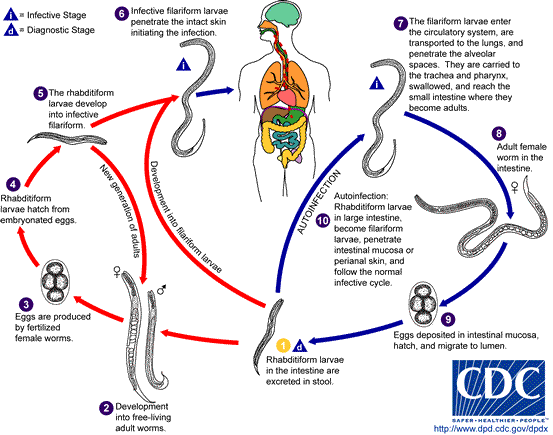The nematode (roundworm) Strongyloides stercoralis. Other Strongyloides include S. fülleborni, which infects chimpanzees and baboons and may produce limited infections in humans.

The Strongyloides life cycle is more complex than that of most nematodes with its alternation between free-living and parasitic cycles, and its potential for autoinfection and multiplication within the host. Two types of cycles exist:
Free-living cycle: The rhabditiform larvae passed in the stool can either molt twice and become infective filariform larvae (direct development) or molt four times and become free living adult males and females that mate and produce eggs from which rhabditiform larvae hatch. The latter in turn can either develop into a new generation of free-living adults or into infective filariform larvae. The filariform larvae penetrate the human host skin to initiate the parasitic cycle.
Parasitic cycle: Filariform larvae in contaminated soil penetrate the human skin, and are transported to the lungs where they penetrate the alveolar spaces; they are carried through the bronchial tree to the pharynx, are swallowed and then reach the small intestine. In the small intestine they molt twice and become adult female worms. The females live threaded in the epithelium of the small intestine and by parthenogenesis produce eggs, which yield rhabditiform larvae. The rhabditiform larvae can either be passed in the stool. In autoinfection, the rhabditiform larvae become infective filariform larvae, which can penetrate either the intestinal mucosa (internal autoinfection) or the skin of the perianal area (external autoinfection); in either case, the filariform larvae may follow the previously described route, being carried successively to the lungs, the bronchial tree, the pharynx, and the small intestine where they mature into adults; or they may disseminate widely in the body. To date, occurrence of autoinfection in humans with helminthic infections is recognized only in Strongyloides stercoralis and Capillaria philippinensis infections. In the case of Strongyloides, autoinfection may explain the possibility of persistent infections for many years in persons who have not been in an endemic area and of hyperinfections in immunodepressed individuals.
Life cycle image and information courtesy of DPDx.
For more information view the source:Center for Disease Control
Recommended Test:Full GI Panel
Recommended Product:Freedom Cleanse Restore Parasite Cleanse